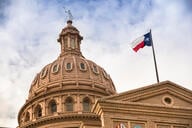You have /5 articles left.
Sign up for a free account or log in.
Warning: I am writing this article as an administrator without first seeking permission and you are reading something you’re not supposed to know. I write because my narrative may not just be indicative of the shortsightedness of one university administrator. It may well be connected to a disturbing trend that markets universities as if they were for-profit corporations. When image control and raising money are the top priorities, the combination can lead to censorship and the curbing of academic freedom.
Having had the opportunity to look at academe from both sides now — as professor and administrator — I’m disillusioned. The divide I had always suspected between faculty and administration seems quite real, and any ideals I might have entertained of mutual respect have been tarnished. Still, if as Joni Mitchell claims, “something lost is something gained,” perhaps by reflecting on the details of my disillusionment, I can ward off cynicism and gain a measure of sanguinity.
As a professor of English and feminist critic for 20 years, I have always hoped to be an assertive advocate for women in academe. Such an opportunity presented itself in the spring of 2008. After months of administrative wrangling, the Women’s Studies and Resource Center (WSRC) was without a director. Someone needed to step in as interim administrator. I had been instrumental in creating the WSRC and didn’t want to see it fail, so I took the opportunity to see how the other half lives and hopefully to resuscitate the center in order to hand it over, healthy and vigorous, to a permanent director one year later. When I started last August, the Center had just been reassigned to a different branch of Academic Affairs — Institutional Diversity and Inclusion — and placed under the auspices of a new associate provost, who in turn reported to a new provost. Faculty members involved in the center simmered with suspicion about the new arrangement. Getting the new administration on the same page with these prickly faculty members seemed challenging, if not impossible.
What did seem achievable was to initiate invigorating programming for the center. Here I could invest my energy and enthusiasm and bring the center back to life for women on campus and in the community. I immediately began planning.
Back in 2002, our Wellness Services and Counseling Center had brought photographer Frank Cordelle’s The Century Project to UNCW. I had been moved and inspired by Frank’s powerful nude portraits of females ages 9 months to 94 years. The exhibit had been well attended and well received. Bringing it back for Women’s History Month 2009 seemed to ensure a surefire hit for the WSRC by effectively underscoring the themes I had chosen for the month: Women’s Bodies/Women’s Lives: Our Bodies, or Theirs?
I don’t think I could have made a better choice. Once again, the project’s exquisite representations of real women, their bodies and their stories, connected with a diverse audience. In five days, almost 1,100 people came, responding to the portraits and the brief stories that accompany them with words like “invaluable,” “inspiring,” “comforting,” “compassionate,” “touching,” “earnest,” “staggering,” “respectful,” and “heroic.” Once again, the Century Project met my expectations by getting busy people to stop, reconsider, and reflect upon women’s bodies and women’s lives.
What I did not expect was the decision by a few UNCW administrators to censor the images of the minors in the exhibit.
Surprisingly, it took only one letter from an angry professor in Oklahoma to our chancellor and provost to bring censorship to UNCW. He portrayed the Century Project as soft-core pornography a la Playboy. In a simultaneous press release, he maintained: “When men are exposed to naked pictures of teenagers and younger girls ... what before was taboo .... now becomes ‘normal.’ .... The girls in such pictures ... forever become tools for masturbation by pedophiles and others seeking to exploit their images. Anyone paying the owner of their image participates in the exploitation of these naked children and teens.”
One would expect that when faced with such dramatically provocative accusations, chancellors and provosts would want to consult with the person responsible for bringing the exhibit to campus — namely the interim director of the WSRC. But that was not to be, and it is here that the rickety bridge between administration and faculty, one that I had been cautiously trying to rebuild, was demolished.
Rather than consult with me, or Frank Cordelle, or with our resident photography professor, who happens to specialize in the nude, or with other women’s studies faculty, or with our journalism and art history professors, or with any faculty for that matter, our chancellor and provost turned instead to fellow administrators, who raised questions about showing images of minors.
Based mostly on these misconceptions, which either Frank Cordelle or I could easily have easily dispelled, a handful of administrators let their own perceptions about the impact a controversy might have on the university’s image (i.e., brand) prevail. If asked, I could have referred them to Frank’s Web site and his book, Bodies and Souls: The Century Project. He makes it very clear that he received parental consents for all the photos of minors and that he remains willing to remove any photos if asked. Rather than cross the divide between administration and faculty to discuss the ethical ramifications of censoring an art exhibit, a privy chamber of six ruled that the images of the girls under 18 were verboten. Their decision was issued as an ultimatum — either censor the project or cancel.
Frank reluctantly agreed to bring the censored exhibit to campus, but he did not simply consent. Instead I provided open forums where Frank could discuss the banned images. I invited professors, student media, university librarians, the director of our community rape crisis center. We worked hard to be sure that open, spirited, and informed conversations occurred all week.
As a result, the project was galvanizing. Students, faculty, staff, and community responded indignantly to the administration’s decision to censor the project with earnest, thoughtful, and often outraged written comments at the project site and in the student newspaper. We were all reminded of the university’s theoretical commitment to nourish new ways of thinking, not hinder them out of fear, and we all came to understand how crucial it is that we steadfastly defend our right to freedom of expression.
So was justice eventually served? Not really.
Freedom of expression was still under assault. When the students published the censored images, they interviewed the provost and printed his remarks, including claims I considered erroneous about the WSRC. When I refuted his mistakes in writing, the administration produced another ultimatum: if I spoke to the press again without first clearing my remarks with Marketing and Communications, I could face a letter of reprimand. Since, this is the policy for all administrators, I had to conform to the policy, even if it meant swallowing untrue accusations. On the ladder of priorities, image came before democratic ethics.
My naive expectations of academic freedom evaporated. Clearly, the upper echelon of administrators was dubious of the lower ranks’ understanding of the “real” world. Ironically, I was told that as a faculty member, I could speak publicly if I made it clear I was speaking as an individual, not as a representative of the university. This was cold comfort as I found myself in an intellectual Catch 22: faculty are respected for their scholarly expertise, but at the same time, they are readily dismissed as impractical — unless, of course, they are from Oklahoma!
And, they were right about me. I am impractical. I continue to value academic freedom over upsetting potential donors.
The divide between faculty and administration, that clichéd “us” against “them” mindset, was firmly in place. Some consolation was to be gained when the Faculty Senate voted overwhelmingly to admonish the administration for failing to consult with campus experts before asking Frank to remove the images of the minors. And there was a sense of poetic justice when three weeks later, the provost resigned his position in order “to pursue other interests” after completing just eight months on the job.
Have lessons been learned? Has mutual respect between administrators and faculty been reestablished at our university? Not really. I was hopeful, but, when asked, the chancellor declined to agree to an inclusive, collaborative, and transparent process for consultation with all relevant parties when administrative concerns arise regarding controversial academic programming.
I return to the English department faculty in the fall, but I wrote this essay while still an administrator, expected to clear these words with Marketing and Communications before I send them off. I won’t. When I did confide in one administrator that I was writing about the Century Project, he immediately advised that I publish anonymously. So much for free speech.
What I can see from both sides now is what could have happened, what still could happen. Administrators need to work harder to raze the divide between administration and faculty, to construct sturdy bridges of mutual respect that encourage communication, consultation, and collaboration. Is it too facile to say, “We’re all in this together”? Shouldn’t all educators be guaranteed freedom of speech — free speech, that is — not speech that first has to be vetted by a marketing director? I believe a university serves its better angels best when it resists autocracy and secrecy and strives for democracy and transparency.
The urge to control discourse is tempting, in our government, in our military, and in our corporations. But in our universities, the consequence of marketing “savvy” is chilling. It erodes the values and morale of discourse communities that should epitomize engaged and informed public citizenry. Given the opportunity to see from both sides of the divide, it is the promise of academic freedom that I worry about, precious and vulnerable.




